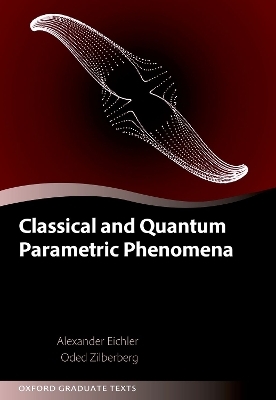
Classical and Quantum Parametric Phenomena
Oxford University Press (Verlag)
978-0-19-286270-9 (ISBN)
Classical and Quantum Parametric Phenomena provides an overview of the phenomena arising when parametric pumping is applied to oscillators. These phenomena include parametric amplification, noise squeezing, spontaneous symmetry breaking, activated switching, cat states, and synthetic Ising spin lattices. To understand these effects, topics such as nonlinear and stochastic dynamics, coupled systems, and quantum mechanics are introduced. Throughout the book, introductions are kept as succinct as possible and attention is focused on understanding parametric oscillators. As a result, the text helps readers to familiarize themselves with many aspects of parametric systems and understand the common theoretical origin of nanomechanical sensors, optical amplifiers, and superconducting qubits.
Parametric phenomena have enabled important scientific breakthroughs over the last decades and are still at the focus of intense research efforts. This book provides a resource for experimental and theoretical physicists entering the field or wishing to gain a deeper understanding of the underlying connections. This includes combining formal and intuitive explanations, accompanied by exercises based on numerical Python codes. This combination allows readers to experience parametric phenomena from various directions and apply their understanding directly to their own projects.
Alexander Eichler studied physics in Basel (Switzerland) from 2000-2005, followed by a doctorate in Christian Schönenberger's group. His first postdoctoral position was in Adrian Bachtold's group in Barcelona (Spain), where he investigated the nonlinear properties of nanomechanical resonators made from carbon nanotubes and graphene. In 2013, he joined the group of Christian Degen at ETH Zürich (Switzerland) to work on magnetic resonance force microscopy. Since 2019 he has been a senior scientist in charge of the group's nanomechanics team. His main interests lie in developing scanning force microscopes with the aim of detecting individual nuclear spins, and the exploration of parametric networks as Ising machines. He is a private docent at ETH since 2022. Oded Zilberberg studied computer science, mathematics, and physics at the Hebrew university in Jerusalem (Israel, 2001-2004). He continued towards a masters in physics in Basel (Switzerland, 2005-2007), and obtained his doctorate on quantum measurements in solids state systems in the group of Yuval Gefen at the Weizmann Institute of Science (Israel, 2008-2012). His postdoctoral position was in Gianni Blatter's group at ETH Zurich (Switzerland, 2013-2015), where he extended his interests to studying material properties, quantum optics, and nonlinear dynamics. Following a year at ABB's corporate research (Switzerland), he started his own research group at ETH Zurich (Switzerland, 2016-2021), and is now a full professor at the University of Konstanz since late 2021.
Introduction
0.1: Historical Review
0.2: Present and Future
1 The Harmonic Resonator
1.1: Newton's Equation of Motion
1.2: Response of the Driven Resonator
1.3: Matrix Formulation
1.4: Parametric Modulation
1.5: Floquet Theory
1.6: Summary of Chapter 1
1.7: Exercises for Chapter 1
2 The Duffing Resonator
2.1: The Quartic Potential
2.2: The Cubic Potential
2.3: Summary of Chapter 2
2.4: Exercises for Chapter 2
3 Degenerate Parametric Pumping
3.1: The Nonlinear Parametric Resonator
3.2: Parametric Pumping via Three-Wave Mixing
3.3: Summary of Chapter 3
3.4: Exercises for Chapter 3
4 Dissipation and Force Fluctuations
4.1: The Role of Force Noise
4.2: The Fluctuation-Dissipation Theorem
4.3: The Probability Distribution Approach
4.4: Summary of Chapter 4
4.5: Exercises for Chapter 4
5 Parametric Resonators with Force Noise
5.1: Multistability and Quasi-Stable Solutions
5.2: Parametric Amplification Below Threshold
5.3: Parametric Pumping Above Threshold
5.4: Hierarchy of Relevant Timescales
5.5: Summary of Chapter 5
5.6: Exercises for Chapter 5
6 Coupled Harmonic Resonators
6.1: Static Coupling
6.2: Nondegenerate Three-Wave Mixing
6.3: Alternative Types of Coupling
6.4: Summary of Chapter 6
6.5: Exercises for Chapter 6
7 Coupled Parametric Oscillators
7.1: Equations for N Coupled Parametric Oscillators
7.2: Examples for N = 2
7.3: Networks with N > 2
7.4: Summary of Chapter 7
7.5: Exercises for Chapter 7
8 The Quantum Harmonic Oscillator
8.1: From Classical to Quantum Fluctuations
8.2: From First to Second Quantization
8.3: Quantum State Representations
8.4: Summary of Chapter 8
8.5: Exercises for Chapter 8
9 From Closed to Open Quantum Systems
9.1: Coupling to a Thermal Environment
9.2: The Driven Quantum Resonator
9.3: Summary of Chapter 9
9.4: Exercises for Chapter 9
10 The Quantum Parametric Oscillator
10.1: General Hamiltonian
10.2: Quantum Parametric Phenomena
10.3: Coupled Quantum Parametric Oscillators
10.4: Summary of Chapter 10
10.5: Exercises for Chapter 10
11 Experimental Systems
11.1: Mechanical Resonator Example
11.2: Electrical Resonator Example
11.3: Optical Resonator Example
11.4: Rescaling of the Numerical Values
11.5: Summary of Chapter 11
11.6: Exercises for Chapter 11
List of Important Symbols
| Erscheinungsdatum | 28.09.2023 |
|---|---|
| Reihe/Serie | Oxford Graduate Texts |
| Zusatzinfo | 83 line drawings and colour images |
| Verlagsort | Oxford |
| Sprache | englisch |
| Maße | 177 x 254 mm |
| Gewicht | 538 g |
| Themenwelt | Naturwissenschaften ► Physik / Astronomie ► Atom- / Kern- / Molekularphysik |
| Naturwissenschaften ► Physik / Astronomie ► Optik | |
| Naturwissenschaften ► Physik / Astronomie ► Quantenphysik | |
| ISBN-10 | 0-19-286270-7 / 0192862707 |
| ISBN-13 | 978-0-19-286270-9 / 9780192862709 |
| Zustand | Neuware |
| Informationen gemäß Produktsicherheitsverordnung (GPSR) | |
| Haben Sie eine Frage zum Produkt? |
aus dem Bereich


